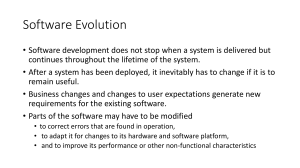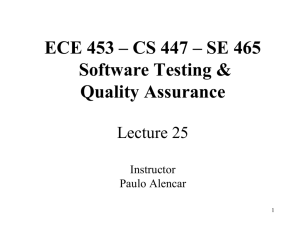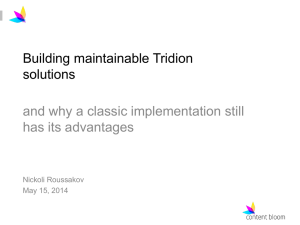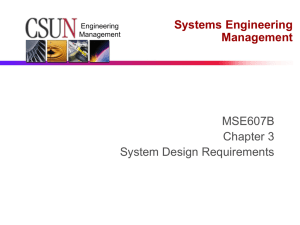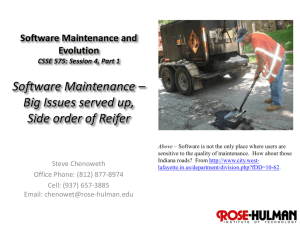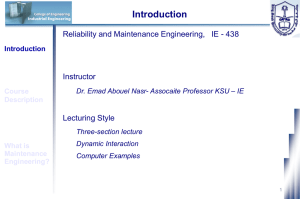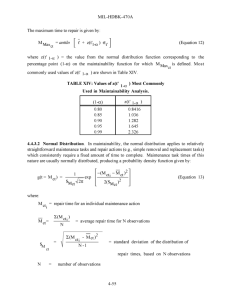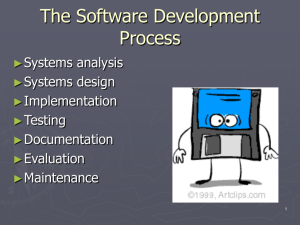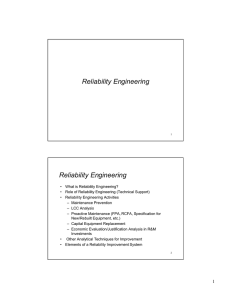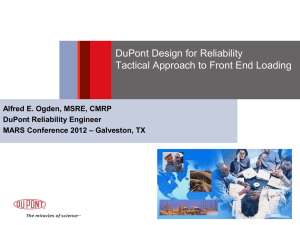Maintenance and Cobfiguration Management
advertisement
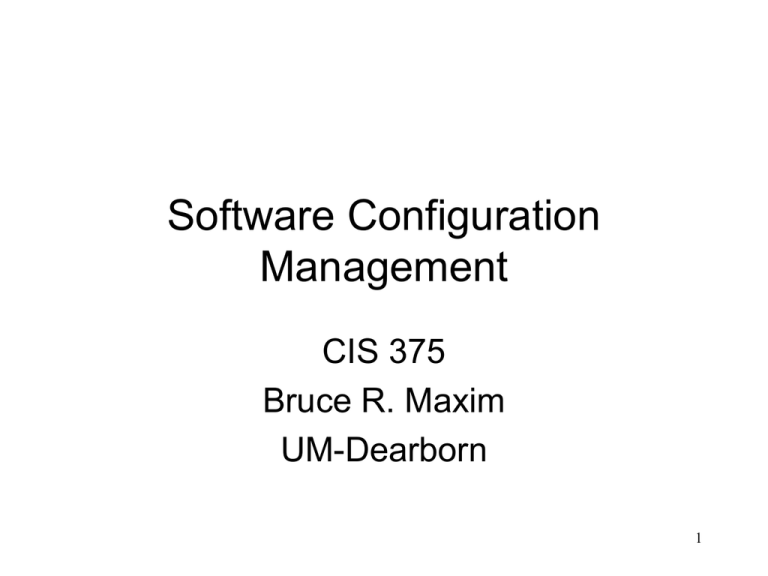
Software Configuration Management CIS 375 Bruce R. Maxim UM-Dearborn 1 Maintenance is Inevitable • System requirements are likely to change while the system is being developed because their environment is changing • Systems are tightly coupled to their environment • When a system is installed it changes the environment and that can change the system requirements • The delivered system may not meet its requirements • Systems must be maintained to remain useful in their environment 2 Types of Maintenance • Corrective Maintenance (21%) – making changes to repair defects • Adaptive Maintenance (25%) – making changes to adapt software to external environment changes (hardware, business rules, OS, etc.) • Perfective Maintenance (50%) – extending system beyond its original functional requirements • Preventative Maintenance (4%) – modifying work products so that they are more easily corrected, adapted, or enhanced 3 Spiral Maintenance Model Implemention Specification Start Release 1 Operation Validation Release 2 Release 3 4 Maintenance Costs • Usually greater than the development costs (2 to 10 times as much in some cases) • Affected by both technical and non-technical factors • Increase as software is maintained and system corruption is introduced • Aging software can have high support costs (e.g. old languages, compilers, etc.) 5 Maintenance Developer Tasks • • • • • • • • • • • Understand system. Locate information in documentation. Keep system documentation up to date. Extend existing functions. Add new functions. Find sources of errors. Correct system errors. Answer operations questions. Restructure design and code. Delete obsolete design and code. Manage changes. 6 Maintenance can be tough • Limited understanding of hardware and software (maintainer). • Management priorities (maintenance may be low priority). • Technical problems. • Testing difficulties (finding problems). • Morale problems (maintenance is boring). • Compromise (decision making problems). 7 Maintenance Cost Factors • Staff turnover – no turnover usually means lower maintenance costs • Contractual responsibility – developers may have no contractual obligation to maintain the delivered system and no incentive to design for future change • Staff skills – maintenance staff are often inexperienced and have limited domain knowledge • Program age and structure – as programs age their structure deteriorates, they become harder to understand and change 8 Maintenance Prediction • Concerned with determining which parts of the system may cause problems and have high maintenance costs • Change acceptance depends on the maintainability of the components affected by the change • Implementing changes degrade system and reduces its maintainability • Maintenance costs depends on number of changes • Costs of change depend on maintainability 9 Maintenance Prediction What parts of the system are most likely to be affected by change requests? What parts of the system will be the most expensive to maintain? Predicting maintainability Predicting system changes How many change requests can be expected? Predicting maintenance costs What will be the lifetime maintenance costs of this system? What will be the costs of maintaining this system over the next year? 10 Maintenance Complexity Metrics • Predictions of maintainability can be made by assessing component complexities • Most maintenance efforts only affect a small number of system components • Maintenance complexity depends on – complexity of control structures – complexity of data structures – module size 11 Maintenance Process Metrics • Maintainability measurements – – – – number of requests for corrective maintenance average time required for impact analysis average time to implement a change request number of outstanding change requests • If any if these increases it may signal a decline in maintainability 12 Maintenance Tools • • • • • • • • Text editors (better than punch cards). File comparison tools. Compilers and linkage editors. Debugging tools. Cross reference generators. Complexity calculators. Control Libraries. Full life cycle CASE tools. 13 Configuration Management • Software changes are inevitable • One goal of software engineering is to improve how easy it is to change software • Configuration management is all about change control. • Every software engineer has to be concerned with how changes made to work products are tracked and propagated throughout a project. • To ensure quality is maintained the change process must be audited. 14 Software Configuration Items • Computer programs – source – executable • Documentation – technical – user • Data – contained within the program – external data (e.g. files and databases) 15 Baselines • A work product becomes a baseline only after it is reviewed and approved. • A baseline is a milestone in software development marked by the delivery of one or more configuration items. • Once a baseline is established each change request must be evaluated and verified before it is processed. 16 Sources of Change • New market conditions dictate changes to product requirements or business rules • New customer needs demand modification of data, functionality, or services • Business reorganization causes changes in project priorities or SE team structure • Budgetary or scheduling constraints require system to be redefined 17 Change Requests • Requests can come from users, customers, or management • Change requests should be carefully analyzed as part of the maintenance process before they are implemented • Some changes requests must be implemented urgently due to their nature – fault repair – system environment changes – urgently required business changes 18 Change Prediction • Predicting the number of changes requires understanding the relationships between a system and its environment • Tightly coupled systems require changes whenever the environment changes • Factors influencing the system/environment relationship – number and complexity of system interfaces – number and volatility of system requirements – business processes where the system is uses 19 Configuration Management Tasks • Identification – tracking changes to multiple SCI versions • Version control – controlling changes before and after customer release • Change control – authority to approve and prioritize changes • Configuration auditing – ensure changes are made properly • Reporting – tell others about changes made 20 Version Control Terms • Entity – composed of objects at the same revision level • Variant – a different set of objects at the same revision level and coexists with other variants • New version – defined when major changes have been made to one or more objects 21 Change Control Process - 1 • Change request is submitted and evaluated to assess its technical merit and impact on the other configuration objects and budget • Change report containing the results of the evaluation is generated • Change control authority (CCA) makes the final decision on the status and priority of the change based on the change report 22 Change Control Process - 2 • Engineering change order (ECO) is generated for each change approved – ECO describes the change, lists the constraints, and criteria for review and audit • Object to be changed is checked-out of the project database subject to access control parameters for the object • Modified object is subjected to appropriate SQA and testing procedures 23 Change Control Process - 3 • Modified object is checked-in to the project database and version control mechanisms are used to create the next version of the software • Synchronization control is used to ensure that parallel changes made by different people don’t overwrite one another 24 Configuration Management Team • Analysts. • Programmers. • Program Librarian. 25 Change Control Board • Customer representatives. • Some members of the Configuration management team. 26 Programmer’s View - 1 • Problem is discovered. • Problem is reported to configuration control board. • The board discusses the problem – is the problem a failure? – is it an enhancement? – who should pay for it? • Assign the problem a priority or severity level, and assign staff to fix it. 27 Programmer’s View - 2 • Programmer or analyst – locates the source of the problem – determines what is needed to fix it • Programmer works with the librarian to control the installation of the changes in the operational system and the documentation. • Programmer files a change report documenting all changes made. 28 Change Control Issues • • • • • • • • • Synchronization (when?) Identification (who?) Naming (what?) Authentication (done correctly?) Authorization (who O.K.’d it?) Routing (who’s informed?) Cancellation (who can stop it?) Delegation (responsibility issue) Valuation (priority issue) 29 Software Configuration Audit - 1 • Has the change specified by the ECO been made without modifications? • Has an FTR been conducted to assess technical correctness? • Was the software process followed and software engineering standards applied? 30 Software Configuration Audit - 2 • Do the attributes of the configuration object reflect the change? • Have the SCM standards for recording and reporting the change been followed? • Were all related SCI's properly updated? 31 Configuration Status Report • • • • What happened? Who did it? When did it happen? What else will be affected by the change? 32
